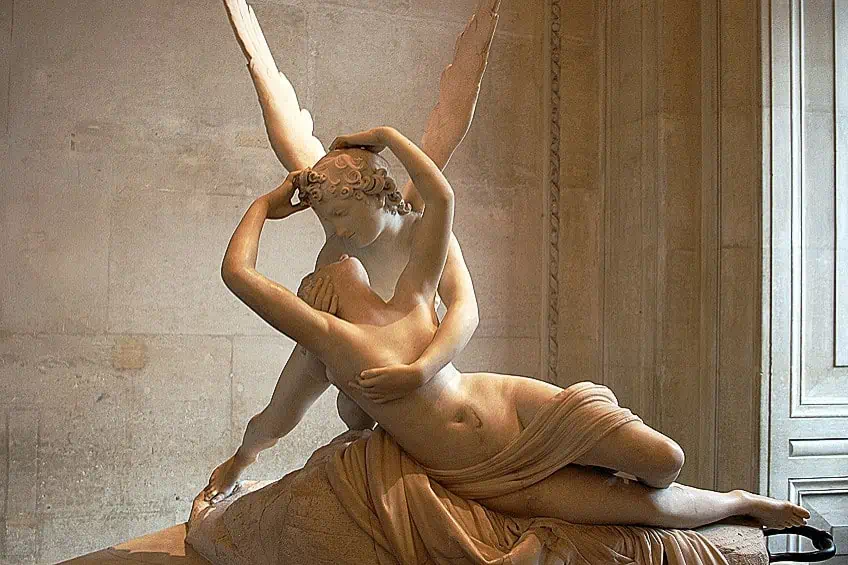Famous Italian Sculptures – Masterpieces in Marble
Dive into the spectacular intricacies of Italian sculptures, which we will unpack in this review of the top 12 most famous Italian sculptures of all time. From iconic works such as Michelangelo’s David to the elegant textures of Gian Lorenzo Bernini’s Apollo and Daphne, you can be sure to learn more about the top 12 Italian sculptures that inspired countless sculptors across the globe. Read on for more about these significant Italian creations and the masterminds behind them!
Contents
- 1 Exploring the History of Italian Sculpture
- 2 Revealing the Top 12 Most Famous Italian Sculptures
- 2.1 David (1430 – 1440) by Donatello
- 2.2 La Pietà (1498 – 1499) by Michelangelo
- 2.3 David (1501 – 1504) by Michelangelo
- 2.4 Moses (1513 – 1515) by Michelangelo
- 2.5 The Risen Christ (1519 – 1521) by Michelangelo
- 2.6 Hercules and Cacus (1525 – 1534) by Baccio Bandinelli
- 2.7 Perseus With the Head of Medusa (1545) by Benvenuto Cellini
- 2.8 The Rape of Proserpina (1621 – 1622) by Gian Lorenzo Bernini
- 2.9 Apollo and Daphne (1622 – 1625) by Gian Lorenzo Bernini
- 2.10 Ecstasy of Saint Teresa (1647 – 1652) by Gian Lorenzo Bernini
- 2.11 Veiled Christ (1753) by Giuseppe Sanmartino
- 2.12 Psyche Revived by Cupid’s Kiss (1793) by Antonio Canova
- 3 Frequently Asked Questions
Exploring the History of Italian Sculpture
Before we dive into the top 12 most famous Italian sculptures, it is best to review the history of Italian sculpture since its development from the Etruscan and Roman civilizations. Italian sculptures have set the benchmark for many artists who aspire to sculpt works and forms with as much perfection and delicacy as the Italian statues and sculptures of legendary names such as Michelangelo and Bernini.
Since antiquity, Italian sculptures were created for funerary purposes, to honor the deceased and portray narrative scenes from their daily life or achievements.
While Roman sculpture focused on the development of realistic forms and idealized representations, inspired by the Greeks, Italian sculpture soon developed its own use of classical subjects to depict themes of power associated with the Empire. In the Renaissance, Italian sculptors paved the way forward for the refinement of sculptural techniques and produced many iconic works, some of which you will learn more about below.
With the rise of experimental forms, styles, and techniques, Italian sculpture shifted toward naturalistic proportions, including intricate reliefs, Baroque styles, and dynamic expressions that truly highlighted the depth possible in Italian sculpture. Throughout the Neoclassical and Romantic movements, Italian sculpture also evolved to explore themes of idealized beauty, as well as elements from the vastly changing socio-political landscape.
Today, the legacies of these fine Italian sculptures continue to inspire many artists to pursue sculpture and develop their techniques, such that their works take on a life of their own!
Revealing the Top 12 Most Famous Italian Sculptures
Italian sculpture has birthed a wide variety of art styles that have impacted the medium of sculpture and how we view the “ideal” forms of sculpture. From explorations of form and narrative to compositional excellence and new representations of classical subjects, these top 12 Italian sculptures are worth your attention!
David (1430 – 1440) by Donatello
| Artist Name | Donato di Niccolò di Betto Bardi (1386 – 1466) |
| Date | 1430 – 1440 |
| Medium | Bronze |
| Dimensions (cm) | 158 |
| Where It Is Housed | Palazzo del Bargello, Florence, Italy |
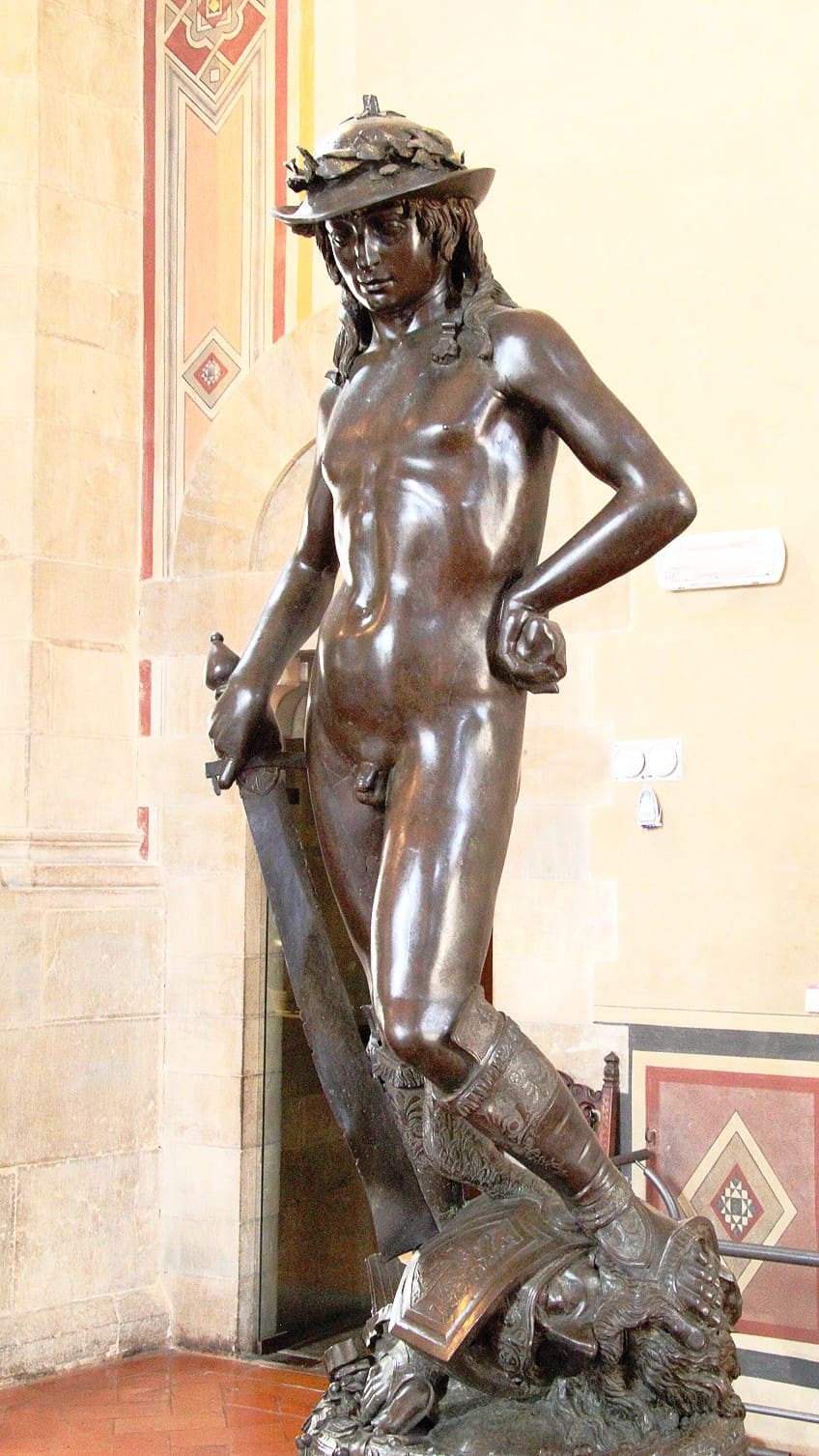
Another iconic David statue was created by Donatello between 1430 and 1440. The Florentine artist, whose name was Donato di Niccolò di Betto Bardi, spent much of his early career developing his knowledge of classical sculpture and traveling through multiple cities to gain inspiration. Donatello then produced the statue of David, which is considered one of the greatest pieces of Italian sculpture.
The statue was cast in bronze and represented the biblical character David, who was celebrated for his heroic efforts in killing the giant Goliath.
What makes the statue so unique is Donatello’s representation of David as a gentle figure, who was portrayed completely in the nude, wearing only a hat and boots, which generated quite the spectacle. Scholars of today believed that the statue contained “homoerotic qualities”, which may indicate the sexuality of the artist and allude to early developments of the queer gaze. Cosimo de Medici commissioned Donatello to create David for his court and was intended to embody the “allegory of civic virtues” and the triumph over ignorance and brute. Today, David can be viewed at the Palazzo del Bargello in Florence.
La Pietà (1498 – 1499) by Michelangelo
| Artist Name | Michelangelo di Lodovico Buonarroti Simoni (professionally known as Michelangelo) (1475 – 1564) |
| Date | 1498 – 1499 |
| Medium | Carrara marble |
| Dimensions (cm) | 174 x 195 |
| Where It Is Housed | St. Peter’s Basilica, Vatican City |
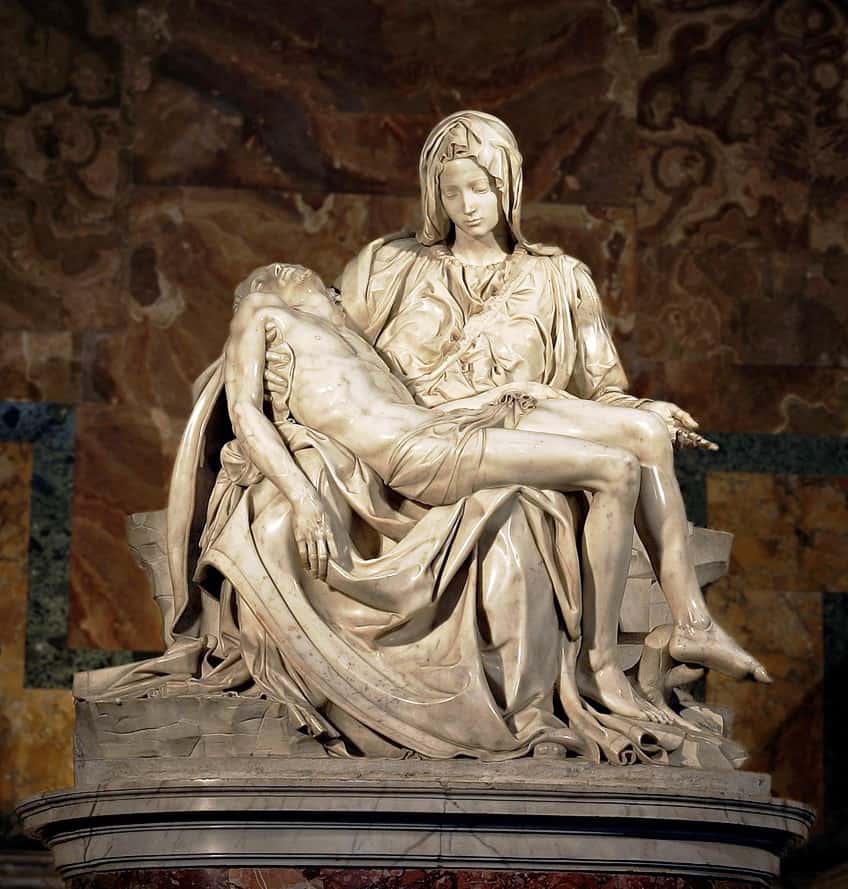
Another iconic sculpture by Italian Renaissance artist Michelangelo is La Pietá. This famous sculpture was first commissioned by Jean de Bilhères de Lagraulas, who was a cardinal and ambassador of the Holy See. The cardinal represented the French monarchy and commissioned Michelangelo to portray the aftermath of Jesus’ crucifixion.
In the sculpture, Michelangelo highlighted the relationship between Mary and her son Jesus, who was portrayed as the corpse.
The structure of Michelangelo’s sculpture was also quite evident since he used a pyramidal format, which left the sculpture with a triangular framework, with the base widening as one’s eye moved down towards the drapery of Mary’s garments and the Golgotha rock. Scholars have also theorized that Michelangelo was inspired by the Divine Comedy penned by Dante Alighieri in 1308. What is even more incredible about this famous sculpture is that Michelangelo completed it when he was only 24 years of age. La Pietá is currently housed at the Saint Peter Basilica in Vatican City.
David (1501 – 1504) by Michelangelo
| Artist Name | Michelangelo di Lodovico Buonarroti Simoni (professionally known as Michelangelo) (1475 – 1564) |
| Date | 1501 – 1504 |
| Medium | Marble |
| Dimensions (cm) | 517 x 199 |
| Where It Is Housed | Galleria dell’Accademia, Florence, Italy |

Described by Giorgio Vasari as incomparable in terms of beauty, proportion, and excellence, this famous Italian sculpture is worthy of your attention. This monumental Italian statue, titled David, was completed by Michelangelo between 1501 and 1504. According to the famous art historian Vasari, Michelangelo was one of the 16th century’s leading sculptors, who created this iconic biblical character statue in a heroic pose.
The famous Italian statue was first commissioned by the Opera del Duomo, which at the time was in charge of running the Cathedral of Florence.
Michelangelo portrayed the heroic character of David in the complete nude while emphasizing the psychological components of his character. For the statue, Michelangelo also leveraged the contrapposto pose, which is a classical pose that was used to make the sculpture stand out as a classical work and was adopted by other artists such as Leonardo da Vinci and Donatello to convey a sense of fluidity. Today, this famous Italian statue can be found at the Galleria dell’Accademia in Florence, Italy.
Moses (1513 – 1515) by Michelangelo
| Artist Name | Michelangelo di Lodovico Buonarroti Simoni (professionally known as Michelangelo) (1475 – 1564) |
| Date | 1513 – 1515 |
| Medium | Marble |
| Dimensions (cm) | 235 x 210 |
| Where It Is Housed | Basilica of San Pietro in Vincoli, Rome, Italy |

Moses is another famous Italian statue created by master sculptor Michelangelo between 1513 and 1515. The statue was created to be mounted in the tomb of Pope Julius II and was considered by Michelangelo himself to be one of his most lifelike sculptures.
An anecdote that follows the creation of a sculpture describes an event where Michelangelo once hit the sculpture with the hammer while exclaiming “Why don’t you speak?”. As such, one can only.
fathom the amazement and reception of the sculpture following the level of realism that Michelangelo embedded in it. In the sculpture, Michelangelo positioned Moses in the pose of a prophet while posed on a marble chair. He also sculpted a long beard on Moses’ face, which descends onto his lap as his right-hand leans on plates.
The Risen Christ (1519 – 1521) by Michelangelo
| Artist Name | Michelangelo di Lodovico Buonarroti Simoni (professionally known as Michelangelo) (1475 – 1564) |
| Date | 1519 – 1521 |
| Medium | Marble |
| Dimensions (cm) | 205 (h) |
| Where It Is Housed | Basilica of Saint Mary of Minerva, Rome, Italy |
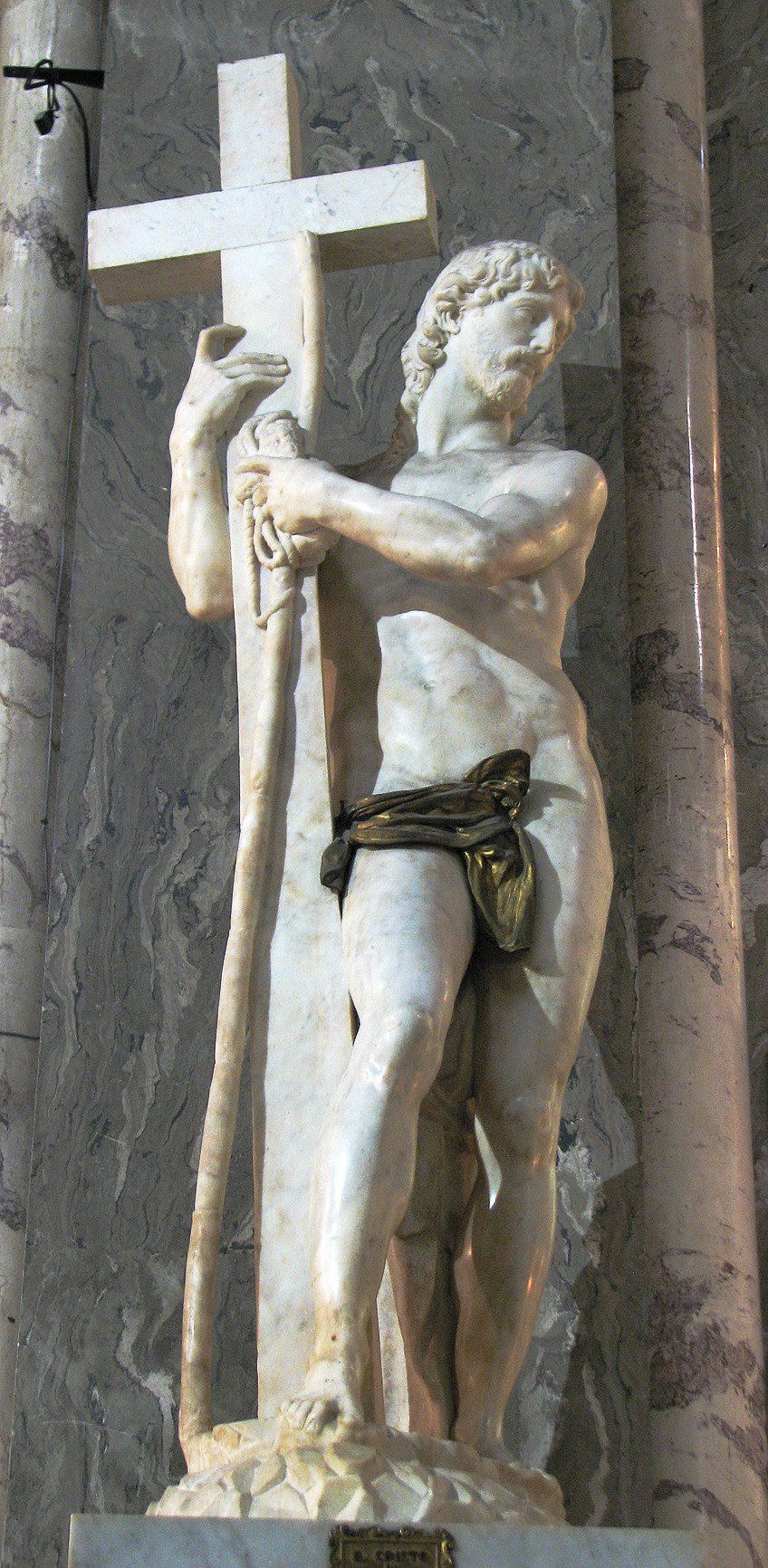
The Risen Christ is among the most famous Italian sculptures that were created by Italian master artist Michelangelo between 1519 and 1521. The piece was commissioned by Metello Vari in 1514 with one instruction, that Jesus was not to bear the cross in his arms. The rest of the design was Michelangelo’s to fathom. Michelangelo first attempted the sculpture in 1515 but had to abandon the marble after he found a black vein running through it.
Entirely upset by the delay, Michelangelo then ordered a new slab and crafted the new Risen Christ between 1519 and 1520 to ensure he honored the agreement.
In the sculpture, Michelangelo exposed Jesus’ sexual organs to demonstrate his uncorrupted sexuality that was completely in his own control, such that his resurrected body would be free from sin. In 1546, a loincloth was incorporated to censor the sculpture. The work is currently on display at the church of Santa Maria Sopra Minerva on the left side of the main altar.
Hercules and Cacus (1525 – 1534) by Baccio Bandinelli
| Artist Name | Baccio Bandinelli (1493 – 1560) |
| Date | 1525 – 1534 |
| Medium | White marble |
| Dimensions (cm) | 304.8 (h) |
| Where It Is Housed | Piazza della Signoria, Florence, Italy |

Hercules and Cacus is a renowned Italian sculpture that was crafted by Baccio Bandinelli between 1525 and 1534. The marble sculpture is currently situated in the Piazza della Signoria in Italy and is regarded as one of the most famous Italian sculptures in history. The sculpture bears a complex history and was commissioned to accompany Michelangelo’s David by the republican council.
The commission portrays the image of Hercules who slays the monster Cacus for stealing his cattle.
Alongside Michelangelo’s figure of spiritual and intellectual strength from David, Hercules, and Cacus would embody physical strength, both of which were symbols highly desired by the Medicis. The marble group was a reminder of the power between the Medici and the vanquished subject, the Republicans. The stillness in Hercules’ figure is also suggestive of the leniency given by the Medicis to those who allowed their rule as well as a threat to those who opposed them.
Perseus With the Head of Medusa (1545) by Benvenuto Cellini
| Artist Name | Benvenuto Cellini (1500 – 1571) |
| Date | 1545 |
| Medium | Bronze and marble |
| Dimensions (cm) | 200 (h) |
| Where It Is Housed | Piazza della Signoria (Loggia di Lanzi), Florence, Italy |
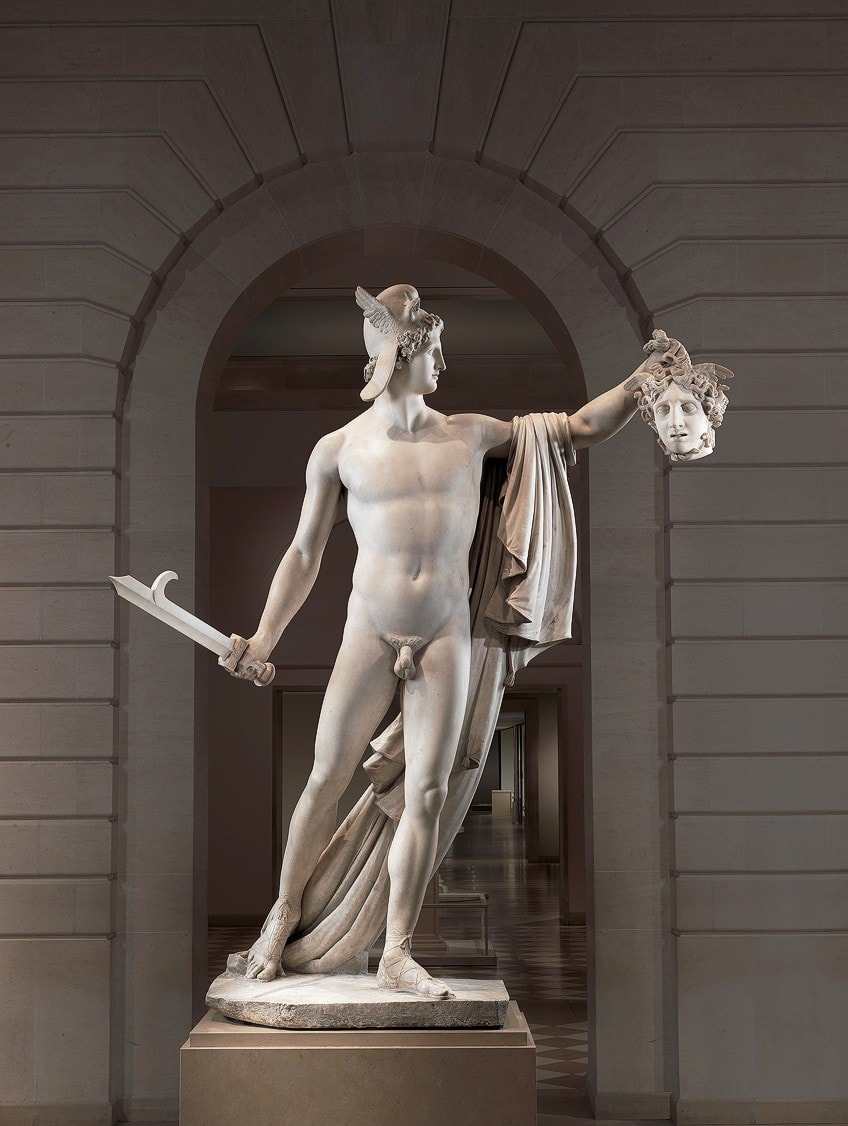
Perseus With the Head of Medusa is another famous Italian sculpture that was created by Benvenuto Cellini in 1545. The sculpture portrays the narrative of Perseus and Medusa and is currently housed at the Piazza della Signoria. The work was commissioned by Duke Cosimo I de Medici, who unveiled the piece in 1554 alongside other previous commissions such as Michelangelo’s David. In the story, Perseus beheads Medusa, who is a mythical Gorgon with snakes on her head that could turn anyone into stone.
Cellini portrayed Perseus as completely nude, except for his sandals and sash, while he held Medusa’s head proudly.
The sculpture was created in bronze and surrounded by other marble sculptures depicting the figures of David, Hercules, and Neptune. Cellini also included a self-portrait on Perseus’ helmet, which was a clever addition to the piece. His choice to work in bronze was also significant since it was the first monumental sculpture created in bronze in more than half a century. Today, the work can be viewed within the Piazza della Signoria, in the Loggia di Lanzi.
The Rape of Proserpina (1621 – 1622) by Gian Lorenzo Bernini
| Artist Name | Gian Lorenzo Bernini (1598 – 1680) |
| Date | 1621 – 1622 |
| Medium | Carrara marble |
| Dimensions (cm) | 225 (h) |
| Where It Is Housed | Galleria Borghese, Rome, Italy |
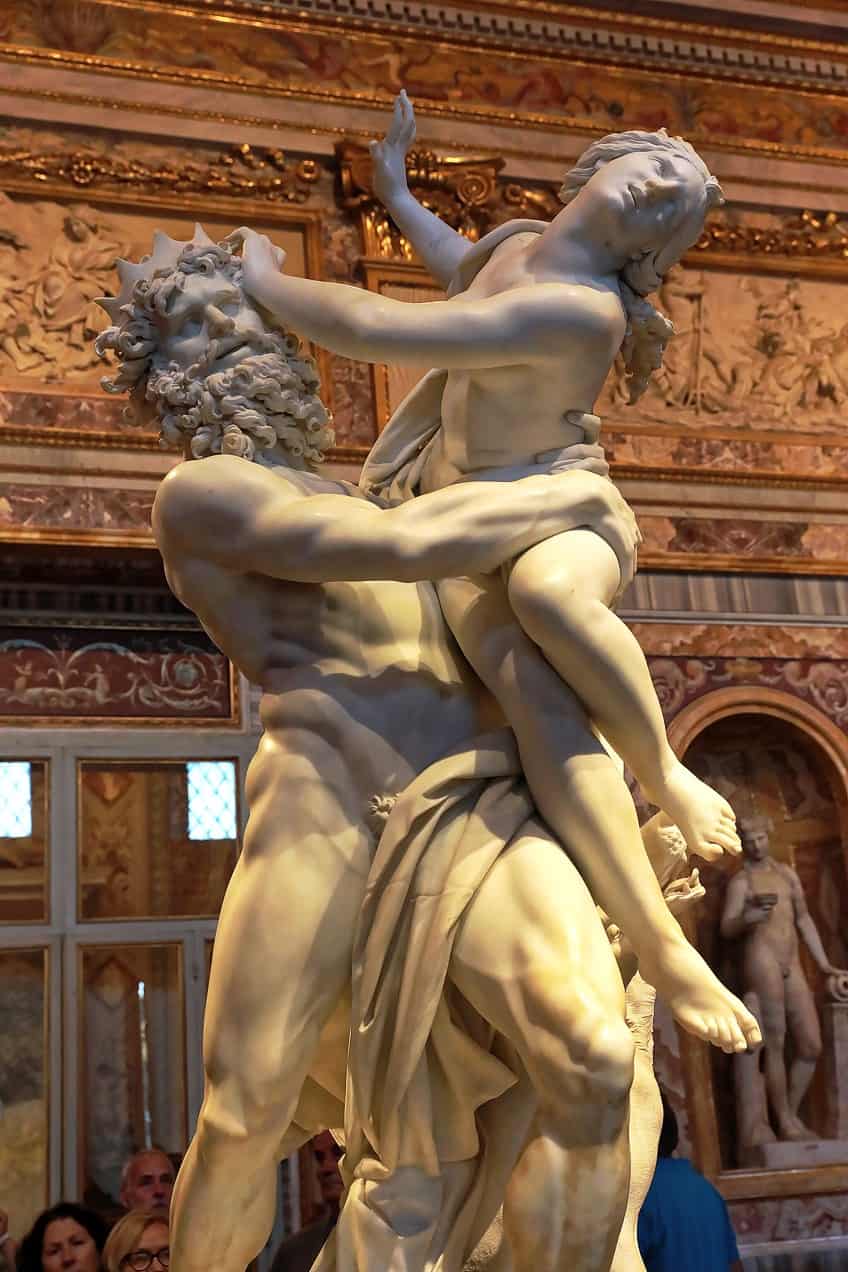
This famous Italian sculpture is also identified as the Abduction of Proserpina and was created by the Italian sculptor Gian Lorenzo Bernini between 1621 and 1622. Bernini created this detailed marble sculpture when he was only 23 years of age and portrayed the abduction of Proserpina by Pluto, who whisked her to the underworld. The sculpture was commissioned by Cardinal Scipione Borghese, who gifted it to his nephew, Ludovico Ludovisi to gain his attention and get his favor. It is believed that the subject was related to the death of Pope Paul V and was inspired by works from Annibale Carracci and Giambologna.
For the sculpture, Bernini used a rare Carrara marble alongside a poem written by Maffeo Barberini. Since then, the sculpture had its pedestal destroyed, however, it has been praised for the detail, delicacy, and realism with which Bernini portrayed the flesh.
All praise given to Bernini’s masterwork was soon put under scrutiny in the 18th and 19th centuries when his reputation started to falter. Critics found fault in the depiction of Pluto’s back, which appeared broken and without character or noble expression on his face. Another critic who encountered the sculpture remarked that Pluto’s head was “vulgarly gay” and “ridiculous”. Regardless of the criticism, The Rape of Proserpina is still considered one of the most famous Italian sculptures to date and can be viewed at the Galleria Borghese in Rome.
Apollo and Daphne (1622 – 1625) by Gian Lorenzo Bernini
| Artist Name | Gian Lorenzo Bernini (1598 – 1680) |
| Date | 1622 – 1625 |
| Medium | Marble |
| Dimensions (cm) | 243 |
| Where It Is Housed | Galleria Borghese, Rome, Italy |

Apollo and Daphne is perhaps one of the most famous Italian Renaissance sculptures of all time. This famous Italian sculpture was created by Gian Lorenzo Bernini between 1622 and 1625. For the sculpture, Bernini portrayed the mythological figures of The Olympian deity Apollo and the huntress of Artemis, Daphne.
The mythological narrative describes the story of Apollo, who fell in love with Daphne after he was shot by an arrow from Eros.
Following this, Daphne fled from Apollo, fearful of his reputation, and even prayed for her beauty to be taken away. In the end, Daphne was turned into a laurel tree, which saw Apollo continue to confess his undying love for her, despite her physical form. Despite receiving both praise and criticism for his depiction of mythological figures, Bernini’s sculpture remains an iconic part of Italian art history, which can be seen at the Galleria Borghese in Rome.
Ecstasy of Saint Teresa (1647 – 1652) by Gian Lorenzo Bernini
| Artist Name | Gian Lorenzo Bernini (1598 – 1680) |
| Date | 1647 – 1652 |
| Medium | Marble |
| Dimensions (cm) | 350 (h) |
| Where It Is Housed | Santa Maria della Vittoria, Rome, Italy |
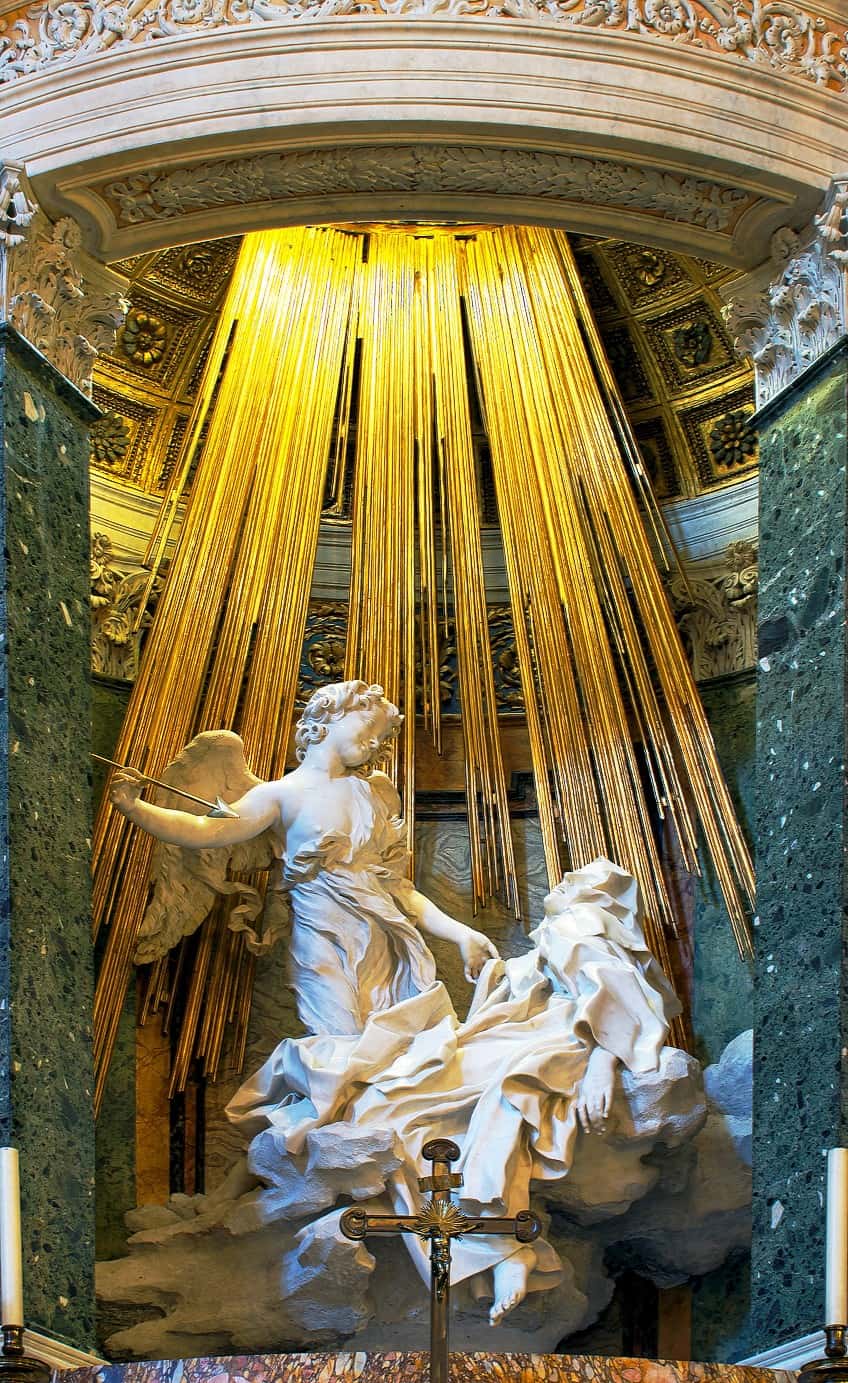
The Ecstasy of Saint Teresa is one of the most famous Italian sculptures situated at the Santa Maria della Vittoria in Rome. Another creation by Gian Lorenzo Bernini, this famous sculpture was created in marble and stucco, decorated in paint. Produced between 1647 and 1652, the sculpture is an iconic work of the High Roman Baroque period that portrays the Spanish nun Teresa of Ávila, engaged in religious ecstasy.
While some have viewed the sculpture as erotic, the true meaning of the scene was to portray the spiritual pleasure of the saint’s encounter with an angel, who pierces her body and sends her into spiritual ecstasy.
The work is considered theatrical since the panels surrounding the work depict viewers who observe the scene, as though watching a play from their boxes. Bernini’s imaginative representation of an encounter with divinity was never expressed in such a sensual way before, which made the mystical scene stand out for centuries.
Veiled Christ (1753) by Giuseppe Sanmartino
| Artist Name | Giuseppe Sanmartino (1720 – 1793) |
| Date | 1753 |
| Medium | White marble |
| Dimensions (cm) | 50 × 80 × 180 |
| Where It Is Housed | Cappella Sansevero, Naples, Italy |

Veiled Christ is another prominent Italian sculpture that was created in 1753 by Giuseppe Sanmartino, who used white marble to depict the frozen Christ, who was laid to rest after his crucifixion. This was simultaneously a scene that occurred before his resurrection, thus making the sculpture profound in its use of tension and realism.
The lifelike depiction of the resting Christ with a veil crafted in the trompe-l’œil style is widely regarded as the masterpiece of the 18th century.
The work was even praised by Antonio Canova, who stated that he would gladly give away 10 years of his life to create such a high-quality sculpture. Today, the famous masterpiece can be viewed at Cappella Sansevero in Naples.
Psyche Revived by Cupid’s Kiss (1793) by Antonio Canova
| Artist Name | Antonio Canova (1757 – 1822) |
| Date | 1793 |
| Medium | Marble |
| Dimensions (cm) | 155 x 168 |
| Where It Is Housed | Louvre Museum, Paris, France |
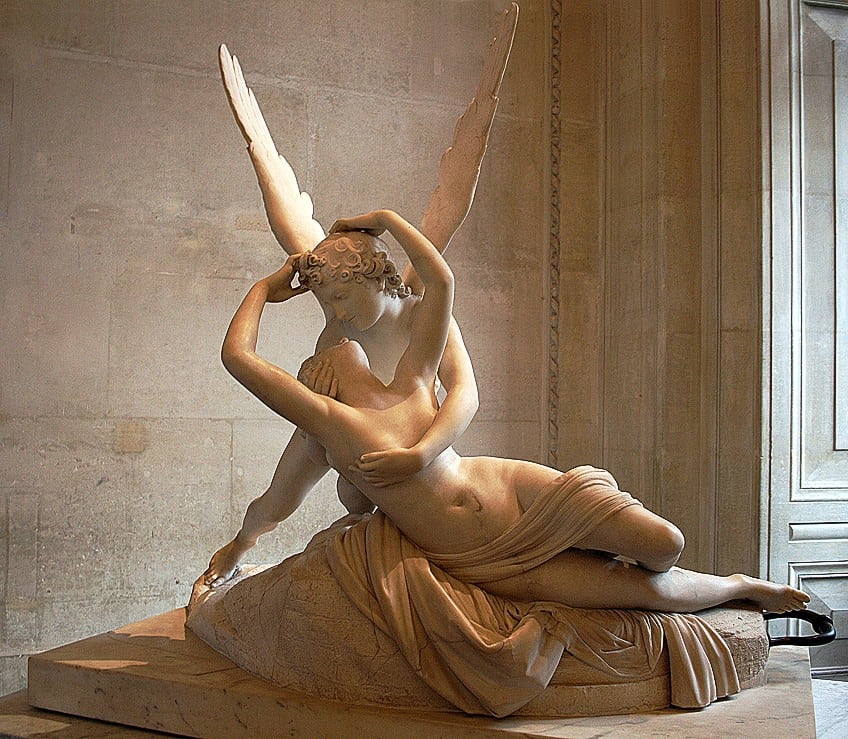
Psyche Revived by Cupid’s Kiss is another iconic Italian sculpture that represents mythological love and the heightened expression of such love and tenderness after an intimate kiss. This famous Italian sculpture was created by Antonio Canova, who was most famous for using literature from the past to inspire his sculptures. Canova derived the story from a Latin novel written by Lucius Apuleius titled The Golden Ass, which is also recognized as Metamorphoses. Canova was also inspired by a Roman painting after he visited Naples around 1787 and chose to represent the scene in a Neoclassical style while evoking themes of Romanticism.
The sculpture portrays the male figure of Cupid, or the God of Eros, with large wings and arrows, who has just shared a kiss with Psyche.
The kiss was not simply a kiss of affection, but rather it was a kiss that saved Psyche’s life after Psyche was instructed by Cupid’s mother to bring her a flask that was filled with poisonous fumes. However, Psyche’s curiosity led her to open the flask and enter into a state of deep sleep. Cupid then revived Psyche after he kissed her to see if she was alive, and then lifted her in a tender embrace. Canova designed the sculpture, such that viewers can admire it from different angles. The potent expression of love and its powerful impression on those who encounter it is undoubtedly profound in conveying the power of love. A few admirable features of the sculpture include Canova’s delicate handling of the marble, as seen on Psyche’s thighs and the folds in her garment. This incredible Italian sculpture can be viewed at the Louvre in Paris.
By studying the 12 most famous Italian sculptures in history, you can truly appreciate the effort and technical prowess of the creators behind these magnificent masterpieces. From the emotional power of Apollo and Daphne to the innovation and impactful impression of The Ecstasy of Saint Teresa, there are many insights that one can learn about the heritage of Italian sculpture.
Frequently Asked Questions
What Is the Most Famous Italian Sculpture?
David (1501 – 1504) by Michelangelo is widely regarded as the most famous Italian sculpture of all time. The masterpiece is recognized as a monumental Italian statue that highlights the intellectual strength of the biblical character David, who triumphed over Goliath using only a stone and slingshot. The statue also adopted the status of a symbol of Florence.
What Is the Tallest Italian Sculpture?
Christ the Redeemer of Maratea (1965) by Bruno Innocenti is considered to be the tallest Italian sculpture to date. The sculpture measures 2,100 centimeters high and is one of the largest statues of Christ in the world. Christ the Redeemer of Maratea is located at Monte San Biagio in the Province of Potenza, Italy.
Why Are Many Italian Sculptures Made from Marble?
Many sculptures created in Italy were crafted from Italian marble since its quality was regarded as superior. Italians were also the first civilization to develop effective quarrying techniques, which enabled them to source high-quality marble from sites such as Carrara. Since ancient times, marble was the preferred medium for sculpture since it offered many advantages over other materials, such as limestone.
Jordan Anthony is a Cape Town-based film photographer, curator, and arts writer. She holds a Bachelor of Art in Fine Arts from the University of the Witwatersrand, Johannesburg, where she explored themes like healing, identity, dreams, and intuitive creation in her Contemporary art practice. Jordan has collaborated with various local art institutions, including the KZNSA Gallery in Durban, the Turbine Art Fair, and the Wits Art Museum. Her photography focuses on abstract color manipulations, portraiture, candid shots, and urban landscapes. She’s intrigued by philosophy, memory, and esotericism, drawing inspiration from Surrealism, Fluxus, and ancient civilizations, as well as childhood influences and found objects. Jordan is working for artfilemagazine since 2022 and writes blog posts about art history and photography.
Learn more about Jordan Anthony and about us.
Cite this Article
Jordan, Anthony, “Famous Italian Sculptures – Masterpieces in Marble.” artfilemagazine – Your Online Art Source. September 20, 2023. URL: https://artfilemagazine.com/famous-italian-sculptures/
Anthony, J. (2023, 20 September). Famous Italian Sculptures – Masterpieces in Marble. artfilemagazine – Your Online Art Source. https://artfilemagazine.com/famous-italian-sculptures/
Anthony, Jordan. “Famous Italian Sculptures – Masterpieces in Marble.” artfilemagazine – Your Online Art Source, September 20, 2023. https://artfilemagazine.com/famous-italian-sculptures/.


